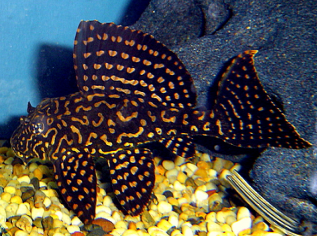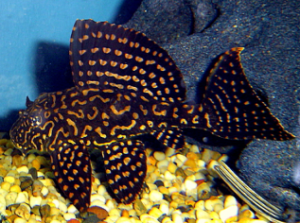

A much sort after monster catfish for a large freshwater tropical aquarium is the stunning Gold Spot Pleco. Pleco’s are flat on the underside from head to tail yet on their top side they are sharply rounded from the front tapering down less sharply to the tail.
Gold Spot Plecos are brightly coloured with golden spots on a brownish background.
Plecos are a scaleless fish that feature bony plates that cover their body – this allows for some protection from predators. The plates cover a (generally) depressed body and often large tail fin. Loricariidae most recognisable feature would be their sucker mouths. The downward facing mouth features modified lips which allow the fish to feed, breathe and attach itself to anything using suction.
Common Name(s) : Gold Spot Pleco, Gold Spotted Pleco, L001, L022
Family : Loricariidae
Genus: Pterygoplichthys
Species : Pterygoplichthys joselimaianus
Origin : South America – Amazon Basin
PH : 6.4 – 8.0
Hardness : Prefer soft / Adaptable from soft to hard
Temperature : 23.0-27.0°C / 73.4-80.6°F
Maximum Size : 30cm / 12″
Lifespan : Up to 15 years
Aggression Level : Low (3/10) They are generally peaceful, can get territorial with those of same species occassionally
Recommended Tank Size : 200 Litres +
Strata : Bottom
TANK SET UP
In the wild Pleco’s hide in driftwood and other dark places by day and come out and hunt for vegetation by night. Therefore it is important to set up the aquarium with plenty of cover for them to hide.
Make no mistake, Plecos will eat cheap bunch plants. Not only that but they commonly uproot bunch plants and you might find your tank set up in tatters after a few hours of your large Pleco roaming around. We sell plant anchors to counter this issue if you are determined to have a well planted tank – wrap two to three of these around each bunch plant to keep your setup looking good.
It is certainly important to choose tough plants such as Amazon Swords, Anubias Plants on Driftwood and Java Fern.
In addition other cover such as caves, rocks or ornaments would definately be an advantage in keeping these fish.
SUITABLE TANK MATES
- Tropical Fish
- Dwarf Cichlids
- African Cichlids
- Some American Cichlids
DIET
Omnivores, young specimens will almost exclusively eat plants, algae wafers, lettuce, cucumber, zucchini, spinach or alike but ensure to anchor any vegetable matter so it will stay at the bottom of an aquarium. Occasionally you might catch them feeding on a dead fish.
Larger specimens also feast on plants, algae wafers, lettuce, cucumber, zucchini, spinach or alike but I find they are also partial to bloodworms or brine shrimp.
SEXING AND BREEDING
Sexing Pleco’s is difficult, venting is the only true way of determining sex. In males there is a small yet thick stump which noticeably protrudes from the fish’s undercarriage. In females it is less obvious and is recessed or lies flat with the body.
OTHER USEFUL INFORMATION
Plecos originate in South America where they inhabit (in particular) the Amazon Basin and its tributaries. There they survive two different types of habitat, cooler rocky or sandy streams or rivers with a water temperature of around 20-24C; or a warmer muddy environment with a water temperature between 24-27 that may have a low oxygen level.
Larger specimens can be territorial toward other Plecos – particularly in aquariums less than 6 foot. It is recommended to only perhaps have one in a tank less than 250 litres.
We find Plecos tolerate a wide range of water conditions in a tropical aquarium, but coming from the Amazon they certainly prefer softer, slightly acidic water. The aquarium should be set up with plenty of hiding places that might include plants, ornaments rocks and driftwood. Most Loricariidaes are nocturnal and are sensitive to light.
As long as the aquarium is lit, the pleco will use its specialized omega iris to keep the light from entering its eyes. When the lights are turned off in the aquarium, the omega iris will open and the fish will start searching for food.
Plecos are omnivores. Smaller specimens may be able to manage on just the existing algae that might grow within the tank, however as the specimen grows then algae chips or pellets should be introduced as well as shelled peas, cucumber, zucchini or generally any soft green vegetable. You might like to skewer vegetables on a tea spoon or anchor them down with a weight. Remove the leftovers within 24 hours.
I find Plecos are not shy at feeding times and will commonly “get in amongst it” with tank mates scrapping for food. As mentioned larger specimens enjoy frozen bloodworm or brine shrimp.
Commonly the reason these fish are kept in a tropical aquarium is for their ability to eliminate algae and reduce the maintenance. They are a brilliant subject for a tropical aquarium and are sure to be a talking point for visitors admiring your home aquarium.
